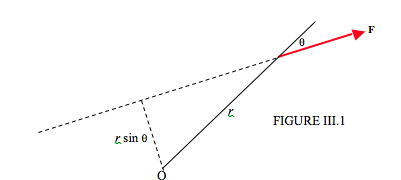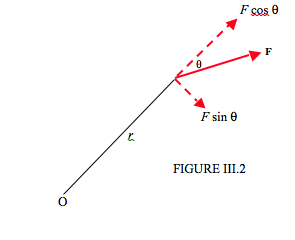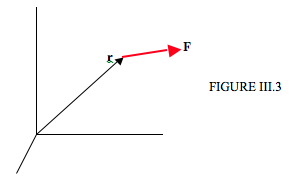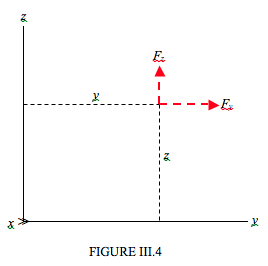3.2: Moment of Force
( \newcommand{\kernel}{\mathrm{null}\,}\)
First, let’s look at a familiar two-dimensional situation. In Figure III.1 I draw a force F and a point O. The moment of the force with respect to O can be defined as
Force times perpendicular distance from O to the line of action of F.

Alternatively, (Figure III.2) the moment can be defined equally well by
Transverse component of force times distance from O to the point of application of the force.

Either way, the magnitude of the moment of the force, also known as the torque, is rFsinθ We can regard it as a vector, τ, perpendicular to the plane of the paper:
τ=r×F
Now let me ask a question. Is it correct to say the moment of a force with respect to (or “about”) a point or with respect to (or “about”) an axis?
In the above two-dimensional example, it does not matter, but now let me move on to three dimensions, and I shall try to clarify.
In Figure III.3, I draw a set of rectangular axes, and a force F, whose position vector with respect to the origin is r.

The moment, or torque, of F with respect to the origin is the vector
τ=r×F
The x−,y− and z -components of τ are the moments of F with respect to the x−,y− and z-axes. You can easily find the components of τ by expanding the cross product 3.2.2:
τ=ˆx(yFz−zFy)+ˆy(yFx−xFz)+ˆz(xFy−yFx)
where ˆx,ˆy,ˆz are the unit vectors along the x,y,z axes. In Figure III.4, we are looking down the x-axis, and I have drawn the components Fy and Fz, and you can see that, indeed, τx=yFz−zFy.

The dimensions of moment of a force, or torque, are ML2T-2, and the SI units are N m. (It is best to leave the units as N m rather than to express torque in joules.)


